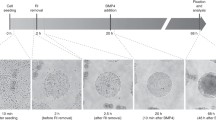Abstract
Human pluripotent stem cells (hPSCs) have the intrinsic ability to differentiate and self-organize into distinct tissue patterns, although this requires the presentation of spatial environmental cues, i.e., biochemical and mechanical gradients. Cell micropatterning technologies potentially offer the means to spatially control stem cell microenvironments and organize the resultant differentiation fates. Here, we describe stencil micropatterning as a simple and robust method to generate hPSC micropatterns for controlling hPSC differentiation patterns. hPSC micropatterns are specified by the geometries of the cell stencil through-holes, which physically confine the locations where the underlying extracellular matrix and hPSCs can access and attach to the substrate. This confers the unique capability of stencil micropatterning to work with a variety of culture substrates and extracellular matrices for optimal hPSC culture. We present the detailed steps of stencil micropatterning to successfully generate hPSC micropatterns, which can be used to investigate how spatial polarization of cell adhesion results in cell fate heterogeneity.
*Author contributed equally with all other contributors
Access this chapter
Tax calculation will be finalised at checkout
Purchases are for personal use only
Similar content being viewed by others
References
Graf T, Stadtfeld M (2008) Heterogeneity of embryonic and adult stem cells. Cell Stem Cell 3(5):480–483. doi:10.1016/j.stem.2008.10.007
S-i N, Goldstein RA, Nierras CR (2008) The promise of human induced pluripotent stem cells for research and therapy. Nat Rev Mol Cell Biol 9(9):725–729. doi:10.1038/nrm2466
Guilak F, Cohen DM, Estes BT, Gimble JM, Liedtke W, Chen CS (2009) Control of stem cell fate by physical interactions with the extracellular matrix. Cell Stem Cell 5(1):17–26. doi:10.1016/j.stem.2009.06.016
Dalby MJ, Gadegaard N, Oreffo RO (2014) Harnessing nanotopography and integrin-matrix interactions to influence stem cell fate. Nat Mater 13(6):558–569. doi:10.1038/nmat3980
Joddar B, Ito Y (2013) Artificial niche substrates for embryonic and induced pluripotent stem cell cultures. J Biotechnol 168(2):218–228. doi:10.1016/j.jbiotec.2013.04.021
Warmflash A, Sorre B, Etoc F, Siggia ED, Brivanlou AH (2014) A method to recapitulate early embryonic spatial patterning in human embryonic stem cells. Nat Methods 11(8):847–854. doi:10.1038/nmeth.3016
Peerani R, Rao BM, Bauwens C, Yin T, Wood GA, Nagy A, Kumacheva E, Zandstra PW (2007) Niche-mediated control of human embryonic stem cell self-renewal and differentiation. EMBO J 26(22):4744–4755. doi:10.1038/sj.emboj.7601896
Lee LH, Peerani R, Ungrin M, Joshi C, Kumacheva E, Zandstra P (2009) Micropatterning of human embryonic stem cells dissects the mesoderm and endoderm lineages. Stem Cell Res 2(2):155–162. doi:10.1016/j.scr.2008.11.004
Hwang Y-S, Chung BG, Ortmann D, Hattori N, Moeller H-C, Khademhosseini A (2009) Microwell-mediated control of embryoid body size regulates embryonic stem cell fate via differential expression of WNT5a and WNT11. Proc Natl Acad Sci 106(40):16978–16983. doi:10.1073/pnas.0905550106
Toh Y-C, Xing J, Yu H (2015) Modulation of integrin and E-cadherin-mediated adhesions to spatially control heterogeneity in human pluripotent stem cell differentiation. Biomaterials 50:87–97. doi:10.1016/j.biomaterials.2015.01.019
Xing J, Toh YC, Xu S, Yu H (2015) A method for human teratogen detection by geometrically confined cell differentiation and migration. Sci Rep 5:10038. doi:10.1038/srep10038
Falconnet D, Csucs G, Grandin HM, Textor M (2006) Surface engineering approaches to micropattern surfaces for cell-based assays. Biomaterials 27(16):3044–3063. doi:10.1016/j.biomaterials.2005.12.024
Bauwens CL, Peerani R, Niebruegge S, Woodhouse KA, Kumacheva E, Husain M, Zandstra PW (2008) Control of human embryonic stem cell colony and aggregate size heterogeneity influences differentiation trajectories. Stem Cells 26(9):2300–2310. doi:10.1634/stemcells.2008-0183
Khademhosseini A, Ferreira L, Blumling Iii J, Yeh J, Karp JM, Fukuda J, Langer R (2006) Co-culture of human embryonic stem cells with murine embryonic fibroblasts on microwell-patterned substrates. Biomaterials 27(36):5968–5977. doi:10.1016/j.biomaterials.2006.06.035
Mohr JC, de Pablo JJ, Palecek SP (2006) 3-D microwell culture of human embryonic stem cells. Biomaterials 27(36):6032–6042. doi:10.1016/j.biomaterials.2006.07.012
Mei Y, Saha K, Bogatyrev SR, Yang J, Hook AL, Kalcioglu ZI, Cho SW, Mitalipova M, Pyzocha N, Rojas F, Van Vliet KJ, Davies MC, Alexander MR, Langer R, Jaenisch R, Anderson DG (2010) Combinatorial development of biomaterials for clonal growth of human pluripotent stem cells. Nat Mater 9(9):768–778. doi:10.1038/nmat2812
Melkoumian Z, Weber JL, Weber DM, Fadeev AG, Zhou Y, Dolley-Sonneville P, Yang J, Qiu L, Priest CA, Shogbon C, Martin AW, Nelson J, West P, Beltzer JP, Pal S, Brandenberger R (2010) Synthetic peptide-acrylate surfaces for long-term self-renewal and cardiomyocyte differentiation of human embryonic stem cells. Nat Biotechnol 28(6):606–610. doi:10.1038/nbt.1629
Evans ND, Minelli C, Gentleman E, LaPointe V, Patankar SN, Kallivretaki M, Chen X, Roberts CJ, Stevens MM (2009) Substrate stiffness affects early differentiation events in embryonic stem cells. Eur Cell Mater 18(1e13d):13e14
Li W, Xu Z, Huang J, Lin X, Luo R, Chen CH, Shi P (2014) NeuroArray: a universal interface for patterning and interrogating neural circuitry with single cell resolution. Sci Rep 4:4784. doi:10.1038/srep04784
Acknowledgements
This work is supported by NUS start-up grant (R-397-000-192-133) and ETPL Gap Fund (R-397-000-198-592). G.S. is an NUS Research scholar. The authors would like to thank Dr. Jiangwa Xing for her technical support on cell micropatterning. The authors have no competing financial interests.
Author information
Authors and Affiliations
Corresponding author
Editor information
Editors and Affiliations
Rights and permissions
Copyright information
© 2016 Springer Science+Business Media New York
About this protocol
Cite this protocol
Yuan, J., Sahni, G., Toh, YC. (2016). Stencil Micropatterning for Spatial Control of Human Pluripotent Stem Cell Fate Heterogeneity. In: Turksen, K. (eds) Stem Cell Heterogeneity. Methods in Molecular Biology, vol 1516. Humana Press, New York, NY. https://doi.org/10.1007/7651_2016_325
Download citation
DOI: https://doi.org/10.1007/7651_2016_325
Published:
Publisher Name: Humana Press, New York, NY
Print ISBN: 978-1-4939-6549-6
Online ISBN: 978-1-4939-6550-2
eBook Packages: Springer Protocols




